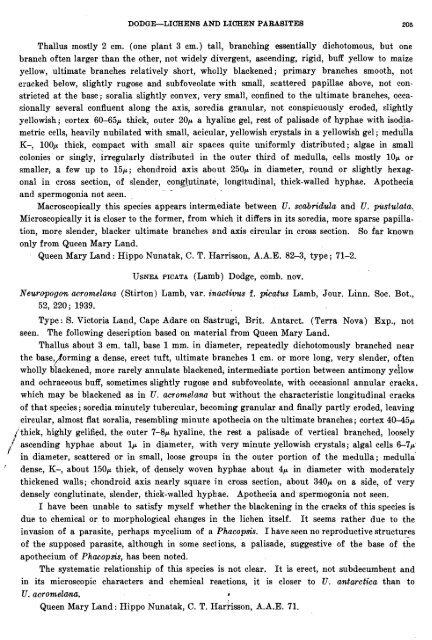Create successful ePaper yourself
Turn your PDF publications into a flip-book with our unique Google optimized e-Paper software.
DODGE--<strong><strong>LICHEN</strong>S</strong> <strong>AND</strong> <strong>LICHEN</strong> <strong>PARASITES</strong> 205<br />
Thallus mostly 2 cm. (one plant 3 em.) tall, branching essentially dichotomous, but one<br />
branch often larger than the other, not widely divergent, ascending, rigid, buff yellow to maize<br />
yellow, ultimate branches relatively short, wholly blackened; primary branches smooth, not<br />
cracked below, slightly rugose and subfoveolate with small, scattered papillae above, not con-<br />
stricted at the base; soralia slightly convex, very small, confined to the ultimate branches, occa-<br />
sionally several confluent along the axis, soredia granular, not conspicuously eroded, slightly<br />
yellowish; cortex 60-65cl thick, outer 20p a hyaline gel, rest of palisade of hyphae with isodia-<br />
metric cells, heavily nubilated with small, acicular, yellowish crystals in a yellowish gel ; medulla<br />
K-, 100p thick, compact with small air spaces quite uniformly distributed; algae in small<br />
colonies or singly, irxqgularly distributed in the outer third of medulla, cells mostly 10p or<br />
smaller, a few up to 15p; chondroid axis about 250p in diameter, round or slightly hexag-<br />
onal in cross section, of slender, conghtinate, longitudinal, thick-walled hyphae. Apothecia<br />
and spermogonia not seen.<br />
Macroscopically this species appears intermediate between 77. scabridda and U. pstulala.<br />
Microscopically it is closer to the former, from which it differs in its soredia, more sparse papilla-<br />
tion, more slender, blacker ultimate branches and axis circular in cross section. So far known<br />
only from Queen Mary Land.<br />
Queen Mary Land : Hippo Nunatak, C. T. Harrisson, A.A.E. 82-3, type ; 71-2.<br />
USNEA PICATA (Lamb) Dodge, comb. nov.<br />
Neuropogm acronzelana (Stirton) Lamb, var. inactivlls f. picatzls Lamb, Jour. Linn. Soc. Bot.,<br />
52, 220 ; 1939.<br />
Type : S. Victoria Land, Cape Adare on Sastrugi, Brit. Antarct. (Terra Nova) Exp., not<br />
seen. The following description based on material from Queen Mary Land.<br />
Thallus about 3 cm. tall, base 1 mm. in diameter, repeatedly dichotomously branched near<br />
the base, f orming a dense, erect tuft, ultimate branches 1 cm. or more long, very slender, often<br />
wholly dlackened, more rarely annulate blackened, intermediate portion between antimony yeilow<br />
and ochraceous buff, sometimes slightly rugose and subfoveolate, with occasional annular cracks,<br />
which may be blackened as in U. montela~na but without the characteristic longitudinal cracks<br />
of that species ; soredia minutely tubercular, beconling granular and finally partly eroded, leaving<br />
circular, almost flat soralia, resembling minute apothecia on the ultimate branches; cortex 40-45cl<br />
('thick, highly gelified, the outer 7-8r, hyaline, the rest a palisade of vertical branched, loosely<br />
ascending hyphae about lp in diameter, with very minute yellowish crystals; algal cells 6-7r,<br />
I' in diameter, scattered or in small, loose groups in the outer portion of the medulla; medulla<br />
' dense, K-, about 150p thick, of densely woven hyphae about 4p in diameter with moderately<br />
thickened walls; chondroid axis nearly square in cross section, about 34OP on a side, of very<br />
densely conglutinate, slender, thick-walled hyphae. Apothecia and spermogonia not seen.<br />
I have been unable to satisfy myself whether the blackening in the cracks of this species is<br />
due to chemical or to morphological changes ir. the lichen itself. It seems rather due to the<br />
invasion of a parasite, perhaps mycelium of a Phacopsis. I have seen no reproductive structures -<br />
of the supposed parasite, although in some seclions, a palisade, suggestive of the base of the<br />
apothecium of Phacopsis, has been noted.<br />
The systematic relationship of this species is not clear. It is erect, not subdecumbent and<br />
in its microscopic characters and chemical reactions, it is closer to U. mtarctica than to<br />
U. acromelmw. @<br />
Queen Mary Land : Hippo Nunatak, C. T. arki is son, A.A.E. 71.

















